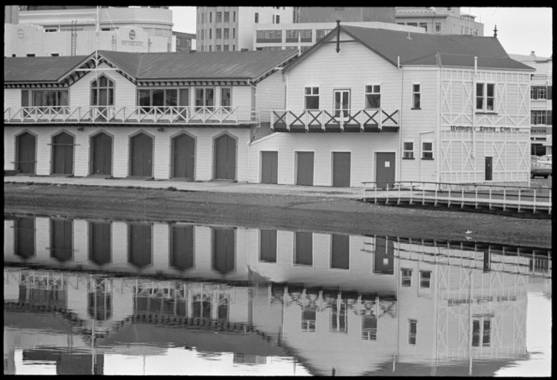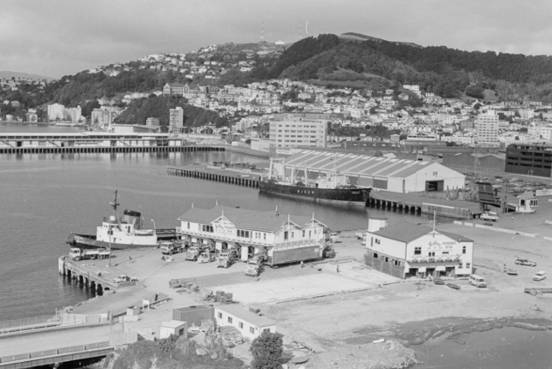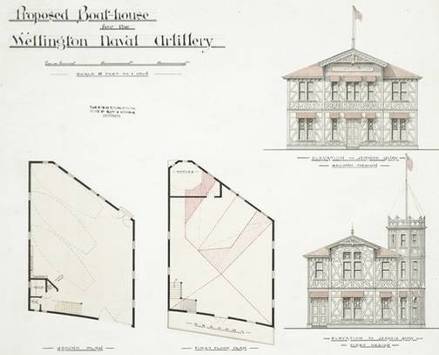The Wellington Rowing Club
Wellington Naval Artillery Volunteers base (1894-1927), Wellington Free Ambulance station (1927-1931), 97 Jervois Quay




National Library reference: Star Boating Club and Wellington Rowing Club, Wellington. Negatives of the Evening Post newspaper. Ref: 1/4-036365-F. Alexander Turnbull Library, Wellington, New Zealand. http://natlib.govt.nz/records/23155116

National Library reference: Star Boating Club, Wellington. Further negatives of the Evening Post newspaper. Ref: EP/1989/3286/13-F. Alexander Turnbull Library, Wellington, New Zealand. http://natlib.govt.nz/records/22301295

-
Constructed
1894 - 1989
-
-
Architect(s)
-
Builder(s)
-
This Victorian military building is a legacy of New Zealand’s late 19th century history, when anxiety about sea invasion led to building defence structures.
Despite many alterations, and its 1992 relocation, the building has kept its octagonal lookout tower, decorative timber ornamentation and external timber boards.
In 1894 it was built as a boathouse for the Wellington Naval Artillery Volunteers (WNAV). In 1927 the building became the Wellington Free Ambulance's first ambulance station until 1931 when The Wellington Rowing Club moved in.
-
Downloadable(s)
-
close
History
-
Originally built as a boat-house for the Wellington Naval Artillery Volunteers (WNAV) in 1894, today the Wellington Rowing Club building is a prominent feature of Wellington's waterfront.
WNAV formed in March 1879. It was one of a number of Naval Artillery Volunteer Corps throughout New Zealand at the time. These groups consisted of men who provided their own uniforms and weapons and carried out military training of their own free will. The WNAV Corps were present at the 1880 Parihaka occupation. Levels of volunteer activity fluctuated throughout the 1880s; the 'Russian Scare' of the early 1880s boosted numbers while the depression conditions of the late 1880s led to a decrease in volunteer activity.
A report on defence issued in 1894 recommended the strengthening of harbour defences to help prevent a possible invasion. This led to the construction of the building which was designed to house two naval cutters on the ground floor, while the first floor was used as a social hall by the volunteers. The crenellated tower was built to provide a lookout. The building was originally sited on reclaimed land on the waterfront. At the time of construction the building was located on Jervois Quay and was situated between the Municipal Fish Market, also erected in 1894, and the then recently relocated Star Boating Club Building.
By 1921 the 15th Coastal Battery absorbed the WNAV into their base at Fort Dorset. From 1927 the building became the Wellington Free Ambulance's first ambulance station. During this time extensive changes were made to the interior of the building: the ground floor was adapted to house four cars, a casualty room was built and the upper floor was converted into accommodation for the superintendent and his family. In 1931 the ambulance organisation moved into its new depot on Cable St.
The Wellington Rowing Club, which had formed in 1871 and was reorganised in 1885, then moved into the former WNAV Hall, and on the 28th of November 1931 the building was officially opened by Mayor Hislop as the clubrooms of the Wellington Rowing Club. The club continues to occupy this building today.
Aside from the building's long association with the Wellington Rowing Club, it has also been used by numerous sporting and cultural clubs such as the Irish National Club, the Wellington Operatic Society, the Mazda Club and the Wellington Winemakers Society. During the early 1970s a joiner operated a factory from the upper floor of the building, making women's wooden shoes and joinery. Dances held in the building during the 1950s, by groups including Bill Crowe and his orchestra, attracted the attention of the Wellington City Council who were concerned that the building was a fire risk and that it might collapse. By the 1970s discussions were underway between the Wellington Rowing Club, the neighbouring Star Boating Club (Record Number 1431) and the Council, who advised that buildings should be demolished and the Clubs re-sited. The two clubhouses, which had been joined by an infill addition since 1931, were deemed to be in poor repair and were referred to as 'an eyesore in the centre of the Capital city'. The Wellington Rowing Club was issued with an eviction notice in 1972 which was later cancelled. Instead, the Wellington Rowing Club building was extensively renovated during 1974-5, including replacing weatherboards, a new roof and the restoration of the balcony.
In 1989, as part of the redevelopment of the harbour, both the Wellington Rowing Club building and the Star Boating Club building were relocated 100 metres north and rotated 180 degrees so that they faced the city rather than the harbour, providing access to the harbour through a more sheltered lagoon. At this time both buildings were also extensively restored and a shared single-storey structure, for housing additional boats, was built connecting the two buildings and continuing the longstanding relationship between the two clubs. The Wellington Rowing Club building was also restored in 1998.
The building continues to be used as club premises and is used as a reception/ conference venue as well.
-
Modifications
close
-
1894
-
Building constructed
-
c.1927
-
Extensive changes including: the ground floor was adapted to house four cars, a casualty room was built, and the upper floor was converted into accommodation
-
1931
-
The building was joined to the Star Boating Club by an infill addition
-
1974 - 1975
-
Extensive renovations including: replacing weatherboards, a new roof, and restoration of the balcony
-
1989
-
Restored and moved 100 metres north and rotated 180 degrees with the Star Boating Club building
-
1989
-
A shared single-storeyed structure, for housing additional boats, was built connecting the two buildings and continuing the longstanding relationship between the two clubs.
-
1998
-
Restored
-
-
Occupation History
close
-
1894 - 1927
-
Wellington Naval Artillery Volunteers base
-
1927 - 1931
-
Wellington Free Ambulance
-
1931
-
Wellington Rowing Club
-
-
-
close
Architectural Information
-
Building Classification(s)
close
Not assessed
-
Architecture
close
Despite modifications and re-siting, the building is well-preserved: a two-storey timber structure with an octagonal tower as its main element of note. An interesting feature of the seaward facade is the extensive use of external timber boarding which crosses over the weatherboards. This vertical, horizontal and diagonal board crossing gives a half-timbered effect and textural interest to the facade. Similar boarding was used on early ecclesiastical structures in New Zealand and in timber lighthouse construction. The boarding, although decorative, enhances the nautical feel of the structure. Old photographs indicate that the half-timbering once covered the entire building. It is not known when this feature was removed from the city elevation.
The building shows an interesting variation of roof line. The city facade has a main gable of low pitch, neatly decorated with pendant, finial and truss. The seaward elevation shows a combination of hipped and gabled roofs which give considerable visual interest to the facades and sets off the robust octagonal tower. Windows are plain double-hung sashes.
The interior has been extensively modified over the years, and the building is a good example of the adaptability of timber-frame buildings in this regard. A balcony was restored on the seaward elevation in 1974-75. The building complements the neighbouring Star Boating Club building and, together, they form a coherent group, with a distinct nautical flavour.
-
Materials
close
The two-storey building was constructed from timber with a corrugated iron roof, and includes features such as a tower and the use of decorative timber bracing on some of the external walls.
-
Setting
close
The building is located at the end of the Taranaki Street Wharf. It is situated between the harbour and the lagoon adjacent to Frank Kitts Park. This building is connected to the north with the Star Boating Club building by an infill construction. To the south is the modern Te Raukura: Te Wharewaka o Poneke, a function centre and restaurant built in 2010 and opened in 2011.
-
Building Classification(s)
close
-
close
Cultural Value
The Wellington Rowing Club is a fine example of a Victorian military building. Despite many alterations, and its 1992 relocation, the building is notable for its octagonal tower, and for its decorative scheme made up of timber ornamentation and external timber boarding.
The building is a legacy of the late 19th century period of New Zealand history when great anxiety about a sea-invasion, particularly from Russia, led to the erection of a whole range of defence structures. It was designed by prominent local architect, Frederick de Jersey Clere and has a historic association with the Wellington Naval Artillery Volunteers; the Wellington Free Ambulance; and, since 1931, the Wellington Rowing Club.
Together with the Star Boating Club, the Rowing Club forms part of a distinctive townscape on this part of the Wellington waterfront. These two buildings provide a tangible reminder of Wellington's long standing connections with the harbour.
-
Aesthetic Value
close
-
Architectural
Does the item have architectural or artistic value for characteristics that may include its design, style, era, form, scale, materials, colour, texture, patina of age, quality of space, craftsmanship, smells, and sounds?
The Wellington Rowing Club is a fine example of a Victorian military building. Despite many alterations, and its 1992 relocation, the building is notable for its octagonal tower, and for its decorative scheme made up of timber ornamentation and external timber boarding.
-
Group
Is the item part of a group of buildings, structures, or sites that taken together have coherence because of their age, history, style, scale, materials, or use?
Together with the Star Boating Club, the building is part of a wider grouping of heritage buildings that includes Odlin’s and the Wellington Free Ambulance Building.
-
Townscape
Does the item have townscape value for the part it plays in defining a space or street; providing visual interest; its role as a landmark; or the contribution it makes to the character and sense of place of Wellington?
The relocated Wellington Rowing Club building has considerable townscape value for its picturesque location adjacent to a pleasant waterfront lagoon.
-
-
Historic Value
close
-
Association
Is the item associated with an important historic event, theme, pattern, phase, or activity?
The building is a legacy of the late 19th century period of New Zealand history when great anxiety about a sea-invasion, particularly from Russia, led to the erection of a whole range of defence structures.
-
Association
Is the item associated with an important person, group, or organisation?
The Wellington Rowing Club has considerable historic significance because of its unusual association with the Wellington Naval Artillery Volunteers; the Wellington Free Ambulance; and, since 1931, the Wellington Rowing Club.
It was designed by Frederick de Jersey Clere, a prominent Wellington architect.
-
- Scientific Value close
-
Social Value
close
-
Identity/Sense of place/Continuity
Is the item a focus of community, regional, or national identity? Does the item contribute to sense of place or continuity?
Despite many alterations, and its removal to a new site in the early 1990s, the building has been a key element on Wellington’s waterfront for over 110 years and contributes to the sense of place and continuity of the waterfront recreational precinct.
-
Public Esteem
Is the item held in high public esteem?
The building is likely to be held in high public esteem as it is an attractive, picturesque building set within the recreational zone of the Wellington Waterfront.
-
Sentiment/Connection
Is the item a focus of community sentiment and connection?
Together with the Star Boating Club, the Rowing Club provides a tangible reminder of Wellington's long standing connections with the harbour.
-
-
Level of Cultural Heritage Significance
close
-
Authentic
Does the item have authenticity or integrity because it retains significant fabric from the time of its construction or from later periods when important additions or modifications were carried out?
Despite being relocated and renovated, this building retains a high level of authenticity, with enough of its original exterior form and appearance to give an appreciation of what a striking sight it must have been on Wellington’s waterfront.
-
Rare
Is the item rare, unique, unusual, seminal, influential, or outstanding?
Along with its companion, the Star Boating Club, this building is a notably rare central city timber building.
-
Local/Regional/National/International
Is the item important for any of the above characteristics at a local, regional, national, or international level?
The building is regionally significant due to its architectural and historic value.
-
-
Local / Regional / National / International Importance
close
Not assessed
-
Aesthetic Value
close
-
close
Site Detail
-
District Plan Number
17/ 284
-
Legal Description
LOT 2 DP 436892
-
Heritage New Zealand Listed
1/ Historic Place 1453
-
Archaeological Site
Reclaimed land
-
Current Uses
unknown
-
Former Uses
unknown
-
Has building been funded
No
-
Funding Amount
Not applicable
-
Earthquake Prone Status
124 Notice
-
-
close
Additional Information
-
Sources
close
- “District Plan: Heritage building – Star Boating Club & Wellington Rowing Club”, 1999, 1041-06-STA Vol. 1, Wellington City Council Records.
- Historic Places Trust, “Fredrick de Jersey Clere”, Professional Biographies, accessed January 29, 2013
- Searle, Chloe. Wellington Rowing Club Building, Historic Places Trust website, 2009,
- Wellington City Council, “Taranaki Street Wharf: Wellington Rowing Club,” Wellington Heritage Building Inventory 2001: Non-Residential Buildings. (Wellington City Council, 2001), TARAW1.
- Technical Documentation close
-
Footnotes
close
Not available
-
Sources
close
Last updated: 11/23/2016 9:33:47 PM
